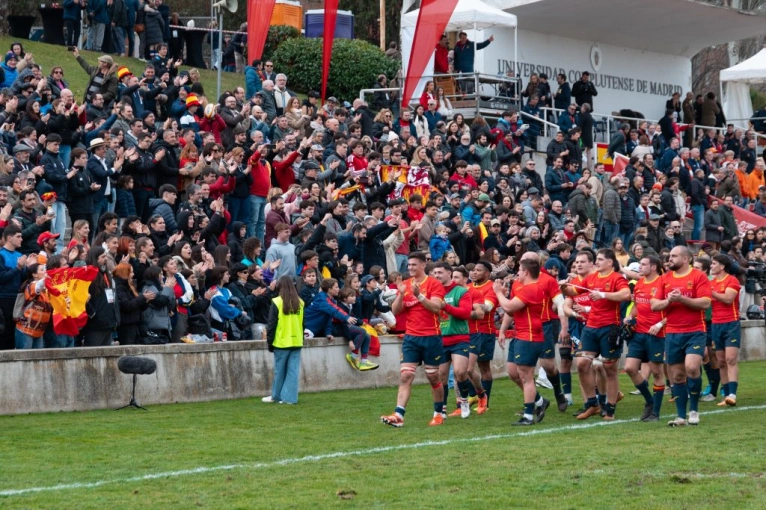Is Spain rugby’s next great superpower?

‘Caminante no hay camino, se hace camino al andar’
Wayfarer, there is no way. Make your way by going farther.
From Antonio Machado’s ‘Proverbios y cantares’.
There is no denying Spanish rugby is on the rise. While their women’s and men’s teams have qualified for World Cups in 2025 and 2027, their age-grade sides have turned heads and earned accolades, their leading lights play at the top of the European club game and the Leones Sevens clinched a remarkable third place finish on this year’s HSBC SVNS. We may be perched on the precipice of a bright era for this proud Iberian country.
Spain are organised, motivated, and eager to claim their place as a coming force on the rugby landscape.
The nation’s teams have won World Cups in football, handball and basketball, produced such global icons as Rafa Nadal, Marc Marquéz, Fernando Alonso, Seve Ballesteros, Sergio Garcia and Jon Rahm in individual disciplines, and featured prominently across sporting conscious for decades. However, after their men’s side qualified for their only World Cup in 1999, Spain’s rugby footprint has diminished, with Georgia and Portugal surpassing them as emerging powers.

Even though several Spanish players made an impact in the French and English club competitions, when it came to the men’s team, that advantage was limited. Spain were disqualified from the past two World Cups for administrative errors, and stumbled in several make-or-break games, denting their overall progress.
Their women’s side also suffered the disappointment of missing the 2021 World Cup, forcing the Spanish game towards a reckoning, one which ultimately sowed the seeds of resurgence.
Without trying to create a ‘zero to hero’ narrative, it is important to understand the embers to reignite the Leones and Leonas already existed, mixed with the dying ashes of their lost hopes and dreams. The grassroots game had made serious advances, with more boys and girls joining clubs at a young age, despite issues with the geographical population spread across the country’s rugby hotbeds.
Since their bankruptcy in 2014, the Real Federación Española de Rugby was able to reshuffle and enact a plan to get back on track, with Alfonso Feijóo’s presidential tenure ending with a €6m budget, €3.2m more than when he first took office.
That’s our resolve and ambition: to build a system that can compete in a way with France and give Spanish athletes a chance to stay before heading abroad.
Under the current administration, the union boasted record turnover last year and their budget has risen further to €9m in 2025. There’s still a long way to go to reach the same level as basketball and handball, but rugby is beginning to register a blip on the Spanish sporting radar.
By just observing the number of registered players, you can understand why Spanish rugby is growing. They are currently working with a pool of 35,000 licensed players (yes, you read it correctly), a staggering number, especially for a nation outside of the top tier. In Madrid alone, 10,000 players are showing their skills, followed by Catalunya (6,600), Valencia (5,000), Andalucia (4,600), Castilla y León (2,600) and Euskadi (2,270). On top of these numbers, we can also add 4-5,000 more rugby licenses, combining match officials, physios, doctors, team managers and others.
These numbers have easily eclipsed those of Portugal, Romania, Netherlands, Belgium and others from the Rugby Europe community, which helps explain Spanish fans’ frustrations with not being able to consistently qualify for men’s World Cups or ascend to a higher status level in the women’s game.
However, since 2021, Spain has slowly worked their way to the top, and for the second time ever, will have two World Cup teams, while retaining their place in the elite World Rugby Championship at U20 level.

There is work to do to improve the main club divisions, to a level where players need not move for better opportunities. The Men’s Division de Honor is a semi-pro league, with the likes of former BUCS Super Rugby champion Mario Pichardie, Alvar Gimeno, Martiniano Cian, Gonzalo Vinuesa, Estanislao Bay and Matthew Foulds putting their game expertise to good use. The competition has helped some players to reach the Top 14, such as former Bordeaux man Afa Amosa and Dax’s Sam Wasley.
On the women’s side, the Liga Iberdrola is mostly an amateur competition, which explains why some of their best personnel have left to play in France and England. Nonetheless, the number of players is increasing, and clubs have been able to produce generational talents, as is the case with Claudia Peña Hidalgo and Carmen Castellucci. Some clubs have had a go at the professional side of things, hiring talent from all over the globe, such as Black Fern Kate Matau or Canada’s Magali Harvey.
Both competitions are streamed and broadcast, have sponsors and generated enough buzz to the point of being closely followed by non-addicted rugby fans.
It is important to understand the stars have only begun aligning in the past few seasons, and the impact of those changes and improvements will take some years to produce results.
The women’s national team is living in an almost professional environment at the moment, something unimaginable some years ago.
Still, for high performance director Raúl Aspirina Pérez, the national regional academies already placed throughout Spain will be the bedrock for something even more spectacular.
“The plan co-signed by World Rugby was to centre our focus on the Spanish player and how we could improve him in the national academies,” he tells RugbyPass.
“I was hired with the goal of improving the national academies and how they work and have an impact, regionally speaking. Alongside it, my focus is also placed on understanding each player and how they can reach the top, giving them the right tools and means to achieve that objective.
“With time, my work with the Spanish union expanded, encompassing the U18s and U20s, as they are the way forward and the nucleus of the whole project.”
For the 59-year-old former Puma, those academies will create a never-ending cycle of player/staff development which will propel Spain to new heights.

“Nowadays, each national academy has found its way of working, which allows me to redeploy my attention to other areas of the youth system. The idea is to empower those academies with specialised staff, giving them freedom and space to work, and in turn, they can link up with the main body, making suggestions and referencing players.
“It is a virtuous cycle, one that can inspire clubs to have their own academies, creating a system that will make a serious push to implement a high-performance programme more broadly.”
An idea shared by Gabriel Sáez, RFER vice-president for strategy and performance, who, together with José Barrio, has taken the original high performance plan designed by Santiago Santos to the next level.
“We want to create a pathway strong enough to scout players from all over Spain and bring them to our national-regional academies,” he explains. “From that point they will be worked and developed to become future U18s, U20s, and, finally, senior players. That’s our resolve and ambition. To build a system that can compete in a way with France and give Spanish athletes a chance to stay before heading abroad.”
The recent sevens rise to power and World Cup qualifications are just the tip of the iceberg, with the youth grades being the cornerstone of the whole project.
These young players need to experience high-level competition to find out what they are missing, what they can improve.
“The U20s have made serious strides, with their victory in the U20 World Trophy in 2023 or retaining their place in the 2024 World Rugby U20 Championship,” says Aspirina Pérez.
“Those are players who have the means to reach another level of excellence. Some have already played for the national team and/or are playing at a good level in France. The U18s are playing in the Six Nations Festival. These are the experiences and challenges that these youth teams need.
“These young players need to experience high-level competition to find out what they are missing, what they can improve. The national academies will help work on those areas. This is the cycle we seek to install in Spanish rugby, be it for the girls or boys.”
Encouragingly, he says, this attitude is trickling into the club system.
“One of the latest improvements has been how clubs look at their youngsters. They now give them more opportunities to play for the senior team. This is vital for the project. If they play more and are challenged from a young age, they will ascend to a higher quality level.”
But has the game really progressed that much from a player’s perspective? In the opinion of Laura ‘Bimba’ Delgado, Spain Women’s captain, it has.

“Oh, it changed so much, both on and off the pitch. For example, the women’s national team is living in an almost professional environment at the moment, something unimaginable some years ago. We still have to make further progress and work to foster a project that can push for the women’s game to become more professionalised in Spain.”
Pichardie, one of the key leaders in the men’s side, has a similarly positive view on the changes introduced by the governing body.
“Our coach Pablo Bouza and Raul Aspirina came from a professional environment, adding valuable knowledge and experience to the Spanish Rugby Union, starting from the bottom. They understood that if the national academies offered the right means to develop young players and give them an extra push, it would mean a better player pool in a few years. You already see that with some of our talents that are making huge waves in the senior team.”
For Pichardie, the signs of growth have already become noticeable, not only in the number of players flocking to the club scene but in the number of spectators in the stands.
I used to be one of the kids who went to Estadio Central to watch Spain play in front of 2,000. Against Fiji this season in Valladolid, there were 20,000.
“I used to be one of the kids who went to Estadio Central to watch Spain play, and there were normally 2,000 people in the stands. Right now, the games we play in Madrid are always full and even against Fiji in Valladolid, there were 20,000 in the stadium.
“It is a sign of growth, in my opinion. I do think the union and clubs are marketing the game better, as more kids are joining our ranks. The positive media repercussion has also benefited us greatly in the last couple of years.”
Delgado shares her view about the importance of rugby becoming a household sport.
“We need to show more love to what we have, so we can share it with more people and augment our following base and player pool. We need more numbers; we need a bigger community that goes beyond players and staff. Families, friends, non-rugby affiliated people… Spanish rugby needs to find a way to reach these groups.
“If we become more visible, more resources and investment will be poured into the sport. That’s a reflection that we must do to progress even further.”
Aspirina Pérez adds: “The Spanish player throws their body on the line for their team, cause and goal, likes to work and enjoys being challenged. Like all Latin players, they are passionate about their team and give their best game in game out. But to jump to the next level, they will need to consume rugby daily. They need to talk about it in their homes, schools, work. They need a rugby environment to further improve as players. I believe if that happens, their progress will greatly increase.”

The quality of coaching has increased in the grassroots game, with former internationals lending their experience to the next generation.
Spain recently defeated World Cuppers Uruguay and Portugal, and performed well against Fiji and Georgia, a clear demonstration something has indeed changed on all levels, as Pichardie himself acknowledges.
“There has been a huge mentality shift. We now play against Fiji and Georgia, believing that we can take them down. We have more confidence, and that change has been one of the bedrocks to our recent good results.”
A mentality shift which, tantalisingly, has gone beyond the lush green pitches of Spain.
“We have the ambition to host the 2035 and 2037 women’s and men’s Rugby World Cups,” Sáez proclaims.
“We have the means, the knowledge and the ability to supply a monumental event like never before, with all due respect to past hosts. Spain is a country built for sporting events, and the Rugby World Cup deserves to head here in the future.”
What seems clear is that players, staff and directors appear to be in harmony, working together as Spain climb the ladder and bid to rub shoulders with those perched at the top.
For a nation of 49 million that has conquered almost every major team and individual sport in the past 30 years, rugby is finally awakening from its long slumber, spurred on by the bitter heartbreak and havoc. The Spaniards’ roar has been heard across the Top 14 and PWR, and now, at every level of the Test match scene.
It is a case of when, not if, they join the party.




